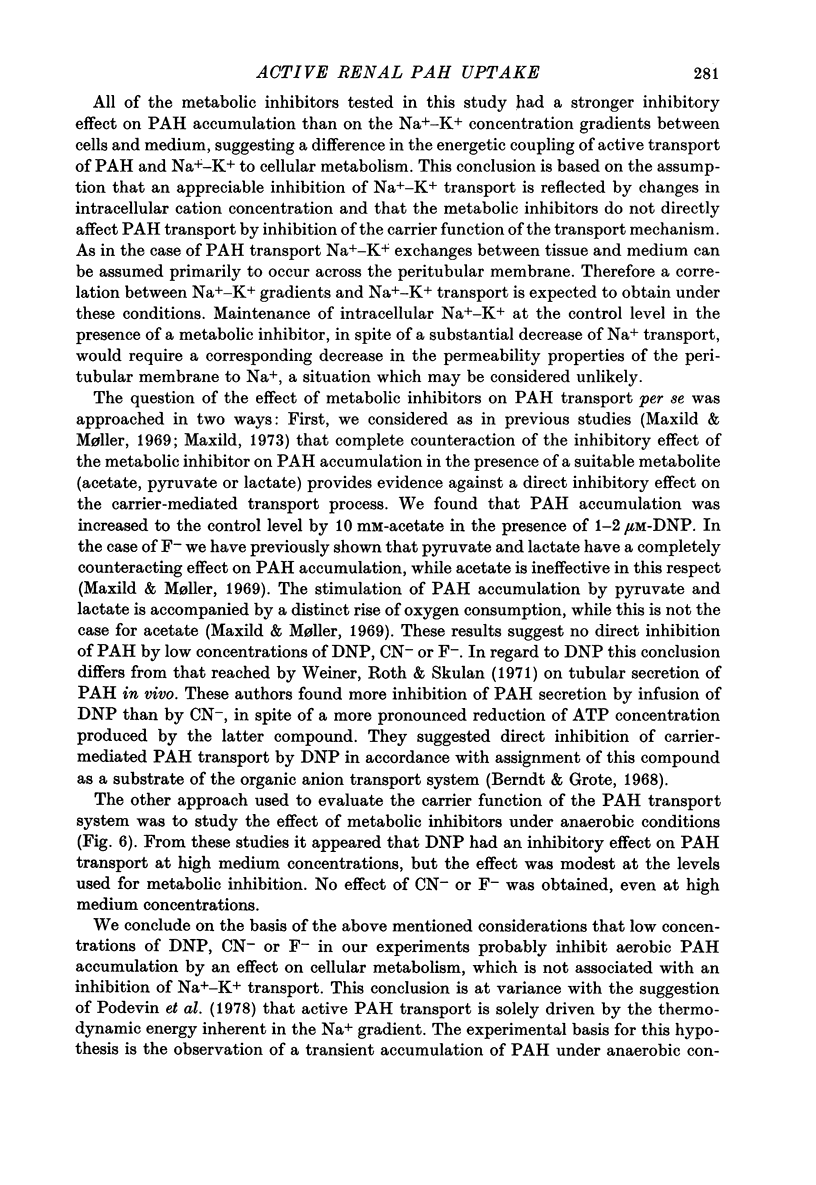Abstract
1. The relation between the coupling of metabolic energy to renal p-aminohippurate (PAH) accumulation and Na+-K+ transport was studied in rabbit cortical slices. 2. Cyanide (CN-), 2,4-dinitrophenol (DNP) and fluoride (F-( at low-medium concentrations, giving rise to a slight decline of tissue ATP concentration, caused a reduction o PAH accumulation without significantly affecting intracellular Na+ and K+ concentrations. However, higher levels of the metabolic inhibitors also resulted in considerable inhibition of active Na+-K+ transport. 3. The rate of carrier-mediated PAH uptake was slow under anaerobic conditions, relative to that measured under aerobic conditions in Na+-depleted slices. In the latter case the maximal accumulation achieved was only 1.55 +/- 0.16. 4. The uptake rate of PAH under anaerobic conditions was not inhibited by the absence of Na+ or addition of metabolic inhibitors in the concentrations used under aerobic conditions. 5. It is concluded that although Na+ is required for the attainment of high accumulation ratios of PAH, oxidative metabolism stimulates PAH flux by a Na+-independent mechanism.
Full text
PDF










Selected References
These references are in PubMed. This may not be the complete list of references from this article.
- Berndt W. O., Grote D. The accumulation of C14-dinitrophenol by slices of rabbit kidney cortex. J Pharmacol Exp Ther. 1968 Nov;164(1):223–231. [PubMed] [Google Scholar]
- COPENHAVER J. H., Jr, FORSTER R. P. Intracellular accumulation as an active process in a mammalian renal transport system in vitro; energy dependence and competitive phenomena. Am J Physiol. 1956 Jul;186(1):167–171. doi: 10.1152/ajplegacy.1956.186.1.167. [DOI] [PubMed] [Google Scholar]
- CROSS R. J., TAGGART J. V. Renal tubular transport: accumulation of p-aminohippurate by rabbit kidney slices. Am J Physiol. 1950 Apr 1;161(1):181–190. doi: 10.1152/ajplegacy.1950.161.1.181. [DOI] [PubMed] [Google Scholar]
- Chung S. T., Park Y. S., Hong S. K. Effect of cations on transport of weak organic acids in rabbit kidney slices. Am J Physiol. 1970 Jul;219(1):30–33. doi: 10.1152/ajplegacy.1970.219.1.30. [DOI] [PubMed] [Google Scholar]
- FOULKES E. C., MILLER B. F. Steps in p-aminohippurate transport by kidney slices. Am J Physiol. 1959 Jan;196(1):86–92. doi: 10.1152/ajplegacy.1958.196.1.86. [DOI] [PubMed] [Google Scholar]
- Gerencser G. A., Hong S. K. Roles of sodium and potassium ions on p-aminohippurate transport in rabbit kidney slices. Biochim Biophys Acta. 1975 Sep 16;406(1):108–119. doi: 10.1016/0005-2736(75)90046-2. [DOI] [PubMed] [Google Scholar]
- Gerencser G. A., Park Y. S., Hong S. K., Solomon S. Sodium influence upon the transport kinetics of p-aminohippurate in rabbit kidney slices. Proc Soc Exp Biol Med. 1973 Nov;144(2):440–444. doi: 10.3181/00379727-144-37608. [DOI] [PubMed] [Google Scholar]
- Kikuta Y., Hoshi T. Role of sodium ions in p-aminohippurate transport by newt kidney. Biochim Biophys Acta. 1979 Jun 2;553(3):404–416. doi: 10.1016/0005-2736(79)90296-7. [DOI] [PubMed] [Google Scholar]
- MUDGE G. H. Electrolyte metabolism of rabbit-kidney slices; studies with radioactive potassium and sodium. Am J Physiol. 1953 Jun;173(3):511–522. doi: 10.1152/ajplegacy.1953.173.3.511. [DOI] [PubMed] [Google Scholar]
- Maxild J. Effect of externally added ATP and related compounds on active transport of p-aminohippurate and metabolism in cortical slices of the rabbit kidney. Arch Int Physiol Biochim. 1978 Aug;86(3):509–530. doi: 10.3109/13813457809055920. [DOI] [PubMed] [Google Scholar]
- Maxild J. Energy requirements for active transport of p-aminohippurate in renal cortical slices. Arch Int Physiol Biochim. 1973 Sep;81(3):501–521. doi: 10.3109/13813457309073400. [DOI] [PubMed] [Google Scholar]
- Maxild J., Moller J. V. Metabolic studies on renal transport of p-aminohippurate in vitro. Biochim Biophys Acta. 1969 Sep 2;184(3):614–624. doi: 10.1016/0304-4165(69)90276-1. [DOI] [PubMed] [Google Scholar]
- Podevin R. A., Boumendil-Podevin E. F. Monovalent cation and ouabain effects on PAH uptake by rabbit kidney slices. Am J Physiol. 1977 Mar;232(3):F239–F247. doi: 10.1152/ajprenal.1977.232.3.F239. [DOI] [PubMed] [Google Scholar]
- Podevin R. A., Boumendil-Podevin E. F., Priol C. Concentrative PAH transport by rabbit kidney slices in the absence of metabolic energy. Am J Physiol. 1978 Oct;235(4):F278–F285. doi: 10.1152/ajprenal.1978.235.4.F278. [DOI] [PubMed] [Google Scholar]
- SHIDEMAN F. E., RENE R. M., STONEMAN F., REYNOLDS G. Succinate oxidation and Krebs cycle as an energy source for renal tubular transport mechanisms. Am J Physiol. 1951 Jul;166(1):104–112. doi: 10.1152/ajplegacy.1951.166.1.104. [DOI] [PubMed] [Google Scholar]
- Sheikh M. I., Moller J. V. The kinetic parameters of renal transport of p-aminohippurate in vitro. Biochim Biophys Acta. 1970;196(2):305–319. doi: 10.1016/0005-2736(70)90018-0. [DOI] [PubMed] [Google Scholar]
- Sheikh M. I., Stahl M. Characteristics of accumulation of probenecid by rabbit kidney cortical slices. Am J Physiol. 1977 Jun;232(6):F513–F523. doi: 10.1152/ajprenal.1977.232.6.F513. [DOI] [PubMed] [Google Scholar]
- Smith H. W., Finkelstein N., Aliminosa L., Crawford B., Graber M. THE RENAL CLEARANCES OF SUBSTITUTED HIPPURIC ACID DERIVATIVES AND OTHER AROMATIC ACIDS IN DOG AND MAN. J Clin Invest. 1945 May;24(3):388–404. doi: 10.1172/JCI101618. [DOI] [PMC free article] [PubMed] [Google Scholar]
- Spencer A. M., Sack J., Hong S. K. Relationship between PAH transport and Na-K-ATPase activity in the rabbit kidney. Am J Physiol. 1979 Feb;236(2):F126–F130. doi: 10.1152/ajprenal.1979.236.2.F126. [DOI] [PubMed] [Google Scholar]
- Tune B. M., Burg M. B., Patlak C. S. Characteristics of p-aminohippurate transport in proximal renal tubules. Am J Physiol. 1969 Oct;217(4):1057–1063. doi: 10.1152/ajplegacy.1969.217.4.1057. [DOI] [PubMed] [Google Scholar]
- WHITTAM R. Sodium and potassium movements in kidney cortex slices from new-born animals. J Physiol. 1960 Sep;153:358–369. doi: 10.1113/jphysiol.1960.sp006539. [DOI] [PMC free article] [PubMed] [Google Scholar]
- WHITTAM R., WILLIS J. S. ION MOVEMENTS AND OXYGEN CONSUMPTION IN KIDNEY CORTEX SLICES. J Physiol. 1963 Aug;168:158–177. doi: 10.1113/jphysiol.1963.sp007184. [DOI] [PMC free article] [PubMed] [Google Scholar]
- Weiner I. M., Roth L., Skulan T. W. Effects of dinitrophenol and cyanide on TPAH and Na reabsorption. Am J Physiol. 1971 Jul;221(1):86–91. doi: 10.1152/ajplegacy.1971.221.1.86. [DOI] [PubMed] [Google Scholar]
- Woodhall P. B., Tisher C. C., Simonton C. A., Robinson R. R. Relationship between para-aminohippurate secretion and cellular morphology in rabbit proximal tubules. J Clin Invest. 1978 May;61(5):1320–1329. doi: 10.1172/JCI109049. [DOI] [PMC free article] [PubMed] [Google Scholar]


